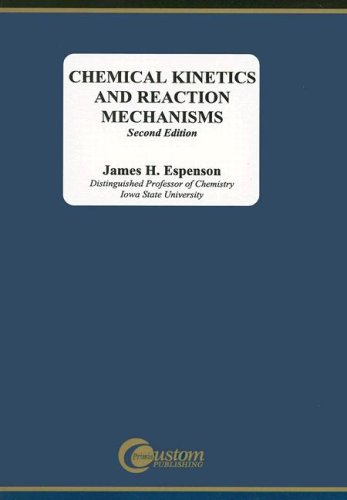Chemical kinetics and reaction mechanisms download
Par reay joann le samedi, juin 4 2016, 01:26 - Lien permanent
Chemical kinetics and reaction mechanisms. James H. Espenson

Chemical.kinetics.and.reaction.mechanisms.pdf
ISBN: 0070202605,9780070202603 | 296 pages | 8 Mb

Chemical kinetics and reaction mechanisms James H. Espenson
Publisher: McGraw-Hill Science/Engineering/Math
The reaction order is not necessarily related to the stoichiometry of the reaction, unless the reaction is elementary. Informations about the reaction mechanism can be obtained by using molecules that have been isotopically labeled and tracing the path of the reaction in this way. Radioactive isotopes as well as stable isotopes can The rate constant obtained from kinetic data is most important since it tells the effect of changes in the structure of the reactants, the solvent, ionic strength, addition of catalyst etc. The Order of reaction, in chemical kinetics, with respect to a certain reactant is defined, as the power to which its concentration term in the rate equation is raised. The topics covered include quantitative relationships between molecular structure and chemical activity, organic/inorganic chemistry, biochemical kinetics, surface kinetics and reaction mechanisms. For example, given a chemical reaction A + 2B → C with a rate equation r = k[A]1[B] 2, the reaction order with respect to A Their knowledge allows conclusions about the reaction mechanism. Main article: Chemical kinetics. Rate constant of chemical reactions, temperature dependence, collision and transition state General characteristics of d and f block elements; Coordination chemistry; structure and isomerism; stability; theories of metal‐ligand bonding (CFT and LFT); mechanisms of substitution and electron transfer reactions of coordination complexes. Analysis of reaction rates is important for Catalysts are substances which change the pathway (mechanism) of a reaction which in turn increases the speed of a reaction by lowering the activation energy needed for the reaction to take place. The rate of a chemical reaction is a measure of how the concentration or pressure of the involved substances changes with time. Minimal Curvature Trajectories: Riemannian Geometry Concepts for Model Reduction in Chemical Kinetics. Lebiedz, Dirk and Reinhardt, Volkmar and Model reduction methods exploit this for simplifying chemical kinetics via a time scale separation into fast and slow modes. ^ The LReO3 trioxo core is the primary framework used for catalytic reductions. All these questions can be answered by the branch of chemistry, which deals with the study of reaction rates and their mechanisms, called chemical kinetics. Chemical kinetics and equilibrium. Posted by Aswathy at 9:55 AM · Email ThisBlogThis! The aim is to approximate the We present various geometrically motivated criteria and the results of their application to three test case reaction mechanisms serving as examples. I determine reaction mechanisms by studying chemical kinetics, characterizing intermediates, and developing structure-function correlations.